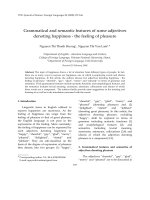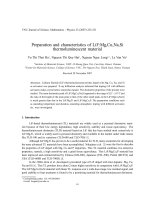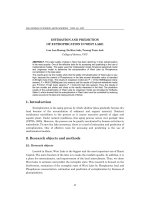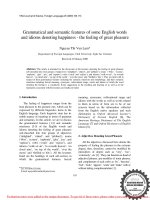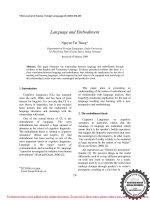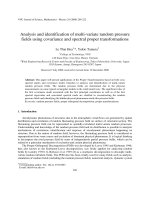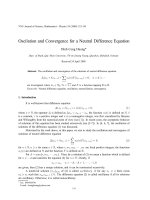Báo cáo CYANIDE AND CRIME
Bạn đang xem bản rút gọn của tài liệu. Xem và tải ngay bản đầy đủ của tài liệu tại đây (2.97 MB, 22 trang )
CYANIDE AND CRIME
Group:
TRAN THI HANH PHUC
DINH THI HUONG
VU TUAN TAI
CONTENT
I. OVERVIEW
II. HEALTH RISK ASSESSMENT
III. FAMOUS CASES
I.OVERVIEW
1.Characteristics:
-Cyanide is a rapidly acting, potentially deadly chemical.
-Cyanide poisoning occurs very quickly, the central medulla paralyzed, the victim lost consciousness
and cardiac arrest after only 1 to 2 minutes.
-It is extremely toxic commonly traded floating in the market, especially in gold mining areas
2.Chemical-Physical properties
a. Chemical structure:
-Cyanides comprise a wide range of compounds with various degrees of chemical complexity, all of
which have the cyanide (CN-) group.
-Major compounds are: Hydrogen cyanide (HCN), Sodium cyanide (NaCN), and Potasssium cyanide
(KCN).
Biochemistry
The cyanide ion (CN-) forms stable but reversible complexes with biologically active metal ions.
Such complexation inhibits the activity of the enzymes containing the metal atom(s).
Cyanide inhibits the activity of numerous enzymes, including cytochrome oxidase, catalase,
peroxidase, nitrogenase, and nitrite and nitrate reductase (Hartung,1982; Solomonson, 1982).
In addition, cyanide can interact with and inhibit nonmetalloenzymes such as ribulose diphosphate
carboxylase.
b. Physical properties
-Colour Clear liquid (hydrogen cyanide)
State/form
Compound
State
Mol.Wt.
Melting point(oC)
o
Boiling point( C)
Vapour pressure
Vapour density
(mm Hg)
(Air=1)
HCN
G
27.04
-13
26
807
0.94
NaCN
S
49.01
564
1496
1
_
KCN
S
65.12
635
_
_
_
-Solubility
Sol: soluble
Sl: slightly soluble
Compound
Water
Ethanol
Ether
HCN
Misc
Sol
Sol
NaCN
Sol
Sl
Sl
KCN
Sol
Sl
_
3. Toxicity
Acute poisoning
Headache, vertigo, weak and rapid pulse, vomiting
Convulsions, falling, dilated pupils, weaker and more rapid pulse
Irregular and slow heart beat, body temperature falls, cyanosis of the lips, face, and extremities,
coma, bloody saliva flow from the mouth and death
Chronic poisoning
Sources: food, water, cigarette smoke
Exacerbated effects: dietary deficiencies in vitamin B12, iodine, and sulphur amino acids
low levels of cyanide: generally metabolised
detoxification rate for humans is <0.001 mg/kg body weight per minute
D-R ASSESSMENT
Inhalation
Acute poisoning: 100 to 1,000 ppm
Intermediate and chronic: 1 to 100 ppm HCN (50 ppm)
Short-term (15-minute) exposure limit: 5.0 ppm
Skin contact
2.3 mg HCN/kg body weight: abraded skin
100 mg HCN/kg body weight: intact skin
Ingestion
bamboo, sorghum, certain fruits, lima beans, cassava
4.0 mg of HCN per kilogram of body weight
HOW YOU COULD BE EXPOSED TO CYANIDE
By breathing air, drinking water, eating food, or touching soil that contains cyanide.
Smoking cigarettes is probably one of the major sources of cyanide exposure for people who do not
work in cyanide-related industries.
Cyanide enters water, soil, or air as a result of both natural processes and industrial activities. In air,
cyanide is present mainly as gaseous hydrogen cyanide.
1955, Haward & Hanzal, for chronic oral exposure
NOAEL= 10.8 mg/kg.day
LOAEL=44mg/kg.day
=> ADI=NOAEL/(UF.MF)
=10.8/(10.10.5)= 0.0216mg/kg.day
- RfD=0.02mg/kg.day
-LD50: 100mg/kg.day for dermal route
-LD50: 1.52mg/kg.day for oral route
Cancer
Cyanide has not been subjected to a complete standard battery of genotoxicity assays, although,
overall, the available data indicate that cyanide is not genotoxic.
No adequate carcinogenicity studies of cyanide are available in animals or humans.
In a 2-year chronic study in rats, no evidence of tumorigenicity was observed (Howard and Hanzal,
1955).
III. METABOLISM AND EXCRETE
Fig. 1: Basic processes involved in the metabolism of cyanide (ATSDR, 1997)
Figure 1: The effects of cyanide within the body. Hydrogen
cyanide gas (HCN) is inhaled and locks onto haemoglobin, the
oxygen-carrying molecule in red blood cells (bottom right). It is
then distributed via the bloodstream to cells throughout the body
where it binds to an important metabolic enzyme called
cytochrome oxidase (bottom left), preventing cells from using
oxygen to produce energy. In this way cyanide effectively
chemically asphyxiates the body.
(Alexandra Lindsay- April 2006)
III. FAMOUS CASES
1. TYLENOL
Within 3 days of the fall of 1982,
seven people in Chicago (USA)
who died after taking Tylenol
mixed with cyanide.
Until now, FBI have not caught the
culprit
3. Le Thanh Van was dubbed “cyanide witches".
From 1/1998 to 8/2001 Van damages killed 13
people and seized nearly 240 million. With her
crimes Le Thanh Van was Binh Duong Province
People's Court sentenced to death for crimes:
Murder, Robbery production and stockpiling and
illegal use of poisons
References
Howard, JW; Hanzal, RF. (1955) “Chronic toxicity for rats of food treated with hydrogen cyanide. J
Agric Food” Chem 3(4):325–329
Alexandra Lindsay (2006) “ Cyanide poisoning” The Naked Scientists: Science Radio & Science
Podcasts
